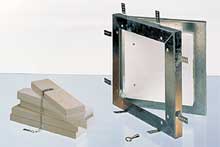Fire protection of the wooden construction elements, building elements, decorative elements and casings.

Wood- that is the material most common for all roof building works in Poland. It has many advantages:
aesthetic, easy to get, easy method of working. Unfortunately is also flammable. Accordingly to the newest EU classification non
protected wood is classified in class D. This means that it takes active part in case of the fire.
With a use of the modern and traditional methods there is possible to improve its fire resistance.
The most often used methods of the protection of wooden roof construction and garret are impregnation and gypsum plate finishing.
Sometimes special methods are needed.
 Impregnation
Impregnation
For the impregnation of wooden constructions usually there are used Ogniochron, Intox S and Fobos M-2. All these chemicals are water
soluble and that’s the reason why they can not be used in case of the contact with water. The roof construction has to be impregnated
after roof assembling to prevent it against rain. This tape of impregnation is work consuming and expensive. To achieve the satisfied
result (second stage of non flammable materials) several layers are needed
 (in case of the very popular Fobos M-2 even eight layers).
Every additional layer means additional cost, time and work. More effective solution is a long term bath.
(in case of the very popular Fobos M-2 even eight layers).
Every additional layer means additional cost, time and work. More effective solution is a long term bath.
Anyway the impregnated wood must be protected against the rain.
Although it is not the only and the best fireproof material the State Fire Brigade Inspectors require it. In other case the building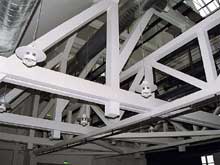 take-over may be blocked.
take-over may be blocked.
Casing
Another way of wood fire protection is a casing with a use of gypsum, silicate or mineral wool plates.
Installation crossing protection between different fire zones.
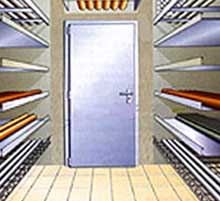
Accordingly to the building law the building has to be divided into separate fire zones. Technical installations like piping and cables
cross the fire zones many times (the fire zones are separated one to another by fireproof walls and ceilings). These crossings have to
pass the same requirements like the separating fireproof walls and ceilings (sufficient fire resistance and tightness).
The cable crossings are tightened with a use of swelling materials that increase its volume in temperature c.a. 150°C.
 It prevents
smoke and fire migration through the separating wall or ceiling. Inside the crossing we may find steel, aluminium or plastic supporting
constructions for cables (cable trays, cable shelves) or even a single cable with diameter below 20mm or cables bunch with diameter
below 100mm.
It prevents
smoke and fire migration through the separating wall or ceiling. Inside the crossing we may find steel, aluminium or plastic supporting
constructions for cables (cable trays, cable shelves) or even a single cable with diameter below 20mm or cables bunch with diameter
below 100mm.
Very popular way of the protection of fire  crossing is a filling the passage with a use mineral wool. Afterwards the cables and wool
are covered with endothermic mass which swells in high temperature. This technology is offered by Pomat, Hilti, Rockwool, SVT.
crossing is a filling the passage with a use mineral wool. Afterwards the cables and wool
are covered with endothermic mass which swells in high temperature. This technology is offered by Pomat, Hilti, Rockwool, SVT.
Another way is to fill the passage with a use of fireproof putty. This solution is proposed by Promat, Hilti. The special putty may
be applied in walls and ceilings made of concrete, brick or cellular concrete. Because it is concrete putty there is not allowed to
use it for walls made of
 gypsum-cartoon plates.
gypsum-cartoon plates.
The Hilti offer also contains the fireproof blocks made of the foamed polyurethane and special fireproof putty to fill the slits
between cables. This system is usually used in laboratories, telecommunication centres, banks etc. because it consists ready to use
elements made of no dusty material. At temperature of 300°C the blocks increase c.a. five times their volume. There is not recommended
to use this system in rooms with humidity level over 80% or externally.

Piping crossings are protected with a use of special bands and cassettes that prevent migration of the smoke and fire through
the fire separating wall or ceiling.
This system is applied if water pipes, sludge water pipes, pneumatic post pipes, vacuum cleaning pipes are made of flammable materials.
In case of the wall crossing the passage must be protected on both sides. In case of the ceiling only the lower
part of the passage has to be protected. Bands are made of swelling material and in case of temperature rise they tighten the burning
pipe.
the lower
part of the passage has to be protected. Bands are made of swelling material and in case of temperature rise they tighten the burning
pipe.
The similar material is used to fill the fire proof cassettes.
Cable and cable trays protection.
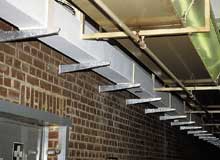
The cable insulation materials are flammable. Hydrogen chloride that is produced while burning of PCV insulation (the most popular
cable insulation material) is very aggressive and toxic. It damages steel constructions, concrete constructions, another installations
and electronics.
As a result the loss of money is huge and may be calculated in millions.
Cable trays are usually installed in corridors and then they reach separate rooms. Unfortunately this space is also used like an
evacuation road so the burning gasses are very dangerous and may blocked the evacuation.

Considering the passive fire protection there are three proposals:
a) cable channels made of Promatec plates (they are produced by PROMAT) that separates cable road into separate fire zone.
These cable channels secure the evacuation roads in case of cable fire. The flame is closed internally and does not migrate.
In case of the external fire cables and cable trays are also secured.
b) self supporting ceilings that creates their own fire zone in space between two ceilings. These systems are offered by PROMAT, KNAUF and RIGIPS.
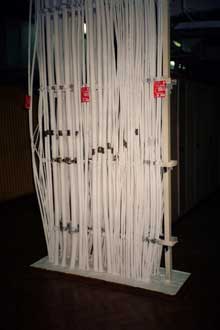
c) endothermic fireproof layers protecting fire migration along the cable roads and hydrogen chloride emission. The layer is non
hygroscopic, ageing resistant, does not need any regeneration, keeps flexibility, does not contain soluble, does not go into reaction
with other materials or cable insulation, does not change any nominal parameters of the cable. We propose coatings FLAMMOPLAST made
by SVT and FLAMRO BMA produced by ROCKWOOL.
Ventilation channels protection.
The fire protection requirements in case of ventilation channels may be divided into two separate aspects: flammability of the channels
as a building material and fire resistance as a building element. Only with a use of properly classified materials and elements we may
decrease the risk of fire migration to other floors, to other fire zones or evacuation roads. Ventilation channels made of metal sheet
do not fulfil fire protection requirements because they are loosing their original shape in case of the fire and than allow for fire
and smoke migration.
There are two fire protection methods for ventilation channels: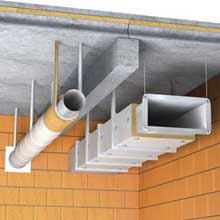
a) the existing metal sheet ventilation channels are surrounded by gypsum plates (RIGIPS, KNAUF), silicate-concrete plates
(PROMAT), or made of mineral wool (CONLIT, PAROC);
b) building separate ventilation channels made of gypsum plates (KNAUF), silicate-concrete (PROMAT), or mineral wool covered with
aluminium foil.
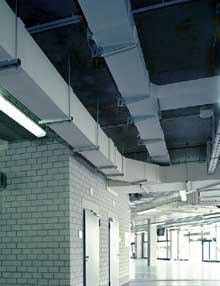
The existing ventilation channels must be protected in case a part of the building has changed its function and it causes additional
fire protection requirements.
More economical way is the installation of independent ventilation channels.
The protected ventilation channels may be utilised for additional function – fire smoke and fire gases transportation channels
that allow keeping evacuation roads and evacuation stairs safe.
Inside ventilation channels and in ventilation hole cutting flaps and fire protecting grills are installed.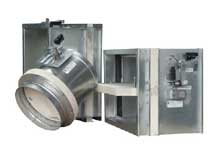
The cutting flaps are self controlled by the mechanism based on the ampoule which brakes and runs the mechanism while heated up or they may be controlled by electronics connected to the central fire detection system.
The fire protection grill is a disposable element. In case of the fire it swallows and closes the ventilation hole.
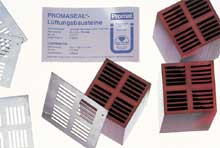 Company PROMAT offers it.
Company PROMAT offers it.
Separating walls and partition building and superstructure of the separating walls and
partition made of gypsum, silicate and mineral wool plates.
We may select several separating elements considering the fire protection technique: fire separating walls, load carrying walls,
partition walls and covering outside walls. To prevent fire migration these elements have to prevent smoke and open fire extension.
Apart of separating function these elements have a static function as a load carrying or stiffening building element.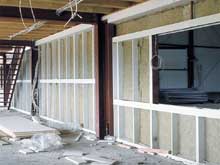
Accordingly to the building requirements this function has to be kept in case of the fire for some time.
The partition walls can be executed as a load carrying or non load carrying elements. In accordance with the requirements their
construction can be done as a single layer version or double layer version i.e. non skeleton walls of the installation shaft, non
load carrying partition wals based on the light steel pillars, load carrying walls based on the steel elements or partition walls
including wooden elements.
It is quite easy to install fireproof door, separating flaps, fireproof glasses, cable and installation fireproof casing there.
To secure the thermal and acoustic insulation additional mineral wool insulation may be applied.
Prevention of dilatation cracks with a use of fireproof masses and foams.
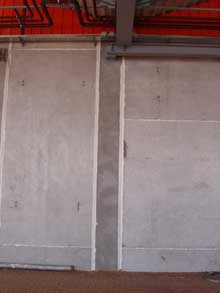 Dilatation cracks are applied in each bigger concrete building. It is because dilatation cracks have to carry out tension caused by
temperature difference, ground subsidence, shocks or concrete cramps. It prevents creation of the random cracks in concrete construction.
Dilatation cracks are applied in each bigger concrete building. It is because dilatation cracks have to carry out tension caused by
temperature difference, ground subsidence, shocks or concrete cramps. It prevents creation of the random cracks in concrete construction.
Many of the concrete constructions are equipped with elastomer or neoprene slide bearings. Even in case of the fire the bearings have
to keep their functionality.
Considering the temperature sensitivity the proper fireproof plate casing may be applied. The casing has to take into consideration
that protected elements are moveable.
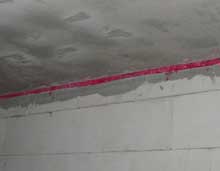
Here you may find several examples: system PYRO-SAFE dilatation produced by SVT, with a use of specialized cracks elements PROMASEAL produced by PROMAT or with a use of fireproof foam PYROPLEX, PROMAT or HILTI.
Fireproof door and trapdoor.

Within a few years we may notice a considerable rise of the demands related to fire protection standards for building industry.
It concerns fire load, additional glasses that improve visibility and orientation, wider door that secure easier and safer evacuation.
Apart of the fire protection and useful function the door and trapdoor have to compose harmoniously with the rest of the building architecture.
- steel door and full wooden door;
- steel door wooden door with glass;
- swing door for cable channels;
- partition wooden walls, steel and profile;
- searching trapdoor.
